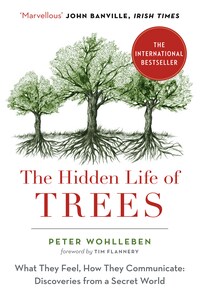COPYRIGHT
William Collins
An imprint of HarperCollinsPublishers 1 London Bridge Street London SE1 9GF
WilliamCollinsBooks.com
This eBook edition published in Great Britain by William Collins in 2017
Originally published in Germany as Das geheime Leben der Bäume. Was sie fühlen, wie sie kommunizieren. Die Entdeckung einer verborgenen Welt. By Peter Wohlleben © 2015 by Ludwig Verlag, a division of Verlagsgruppe Random House GmbH, München, Germany.
The Hidden Life of Trees first published in the English language by Greystone Books Ltd in 2016, Vancouver, Canada.
English translation copyright © 2016 by Jane Billinghurst
Foreword copyright © 2016 by Tim Flannery ‘Note from a Forest Scientist’ copyright © 2016 by Dr. Suzanne Simard
Peter Wohlleben asserts the moral right to be identified as the author of this work. All rights reserved. No part of this publication may be reproduced, stored in a retrieval system, or transmitted, in any form or by any means, electronic, mechanical, photocopying, recording or otherwise, without the prior permission of the publishers.
A catalogue record for this book is available from the British Library.
Copyediting by Shirarose Wilensky
Jacket and interior design by Nayeli Jimenez Jacket and interior illustrations by Briana Garelli
All rights reserved under International and Pan-American Copyright Conventions. By payment of the required fees, you have been granted the non-exclusive, non-transferable right to access and read the text of this e-book on-screen. No part of this text may be reproduced, transmitted, down-loaded, decompiled, reverse engineered, or stored in or introduced into any information storage and retrieval system, in any form or by any means, whether electronic or mechanical, now known or hereinafter invented, without the express written permission of HarperCollins.
Source ISBN: 9780008218430
Ebook Edition © August 2017 ISBN: 9780008218447 Version: 2017-07-24
TABLE OF CONTENTS
Cover
Title Page
Copyright
Foreword by Tim Flannery
Introduction to the English Edition
Introduction
1 / Friendships
2 / The Language of Trees
3 / Social Security
4 / Love
5 / The Tree Lottery
6 / Slowly Does It
7 / Forest Etiquette
8 / Tree School
9 / United We Stand, Divided We Fall
10 / The Mysteries of Moving Water
11 / Trees Aging Gracefully
12 / Mighty Oak or Mighty Wimp?
13 / Specialists
14 / Tree or Not Tree?
15 / In the Realm of Darkness
16 / Carbon Dioxide Vacuums
17 / Woody Climate Control
18 / The Forest as Water Pump
19 / Yours or Mine?
20 / Community Housing Projects
21 / Mother Ships of Biodiversity
22 / Hibernation
23 / A Sense of Time
24 / A Question of Character
25 / The Sick Tree
26 / Let There Be Light
27 / Street Kids
28 / Burnout
29 / Destination North!
30 / Tough Customers
31 / Turbulent Times
32 / Immigrants
33 / Healthy Forest Air
34 / Why Is the Forest Green?
35 / Set Free
36 / More Than Just a Commodity
Note from a Forest Scientist by Dr. Suzanne Simard
Notes
Index
Acknowledgments
About the Publisher
FOREWORD
WE READ IN fairy tales of trees with human faces, trees that can talk, and sometimes walk. This enchanted forest is the kind of place, I feel sure, that Peter Wohlleben inhabits. His deep understanding of the lives of trees, reached through decades of careful observation and study, reveals a world so astonishing that if you read his book, I believe that forests will become magical places for you, too.
One reason that many of us fail to understand trees is that they live on a different time scale than us. One of the oldest trees on Earth, a spruce in Sweden, is more than 9,500 years old. That’s 115 times longer than the average human lifetime. Creatures with such a luxury of time on their hands can afford to take things at a leisurely pace. The electrical impulses that pass through the roots of trees, for example, move at the slow rate of one third of an inch per second. But why, you might ask, do trees pass electrical impulses through their tissues at all?
The answer is that trees need to communicate, and electrical impulses are just one of their many means of communication. Trees also use the senses of smell and taste for communication. If a giraffe starts eating an African acacia, the tree releases a chemical into the air that signals that a threat is at hand. As the chemical drifts through the air and reaches other trees, they “smell” it and are warned of the danger. Even before the giraffe reaches them, they begin producing toxic chemicals. Insect pests are dealt with slightly differently. The saliva of leaf-eating insects can be “tasted” by the leaf being eaten. In response, the tree sends out a chemical signal that attracts predators that feed on that particular leaf-eating insect. Life in the slow lane is clearly not always dull.









